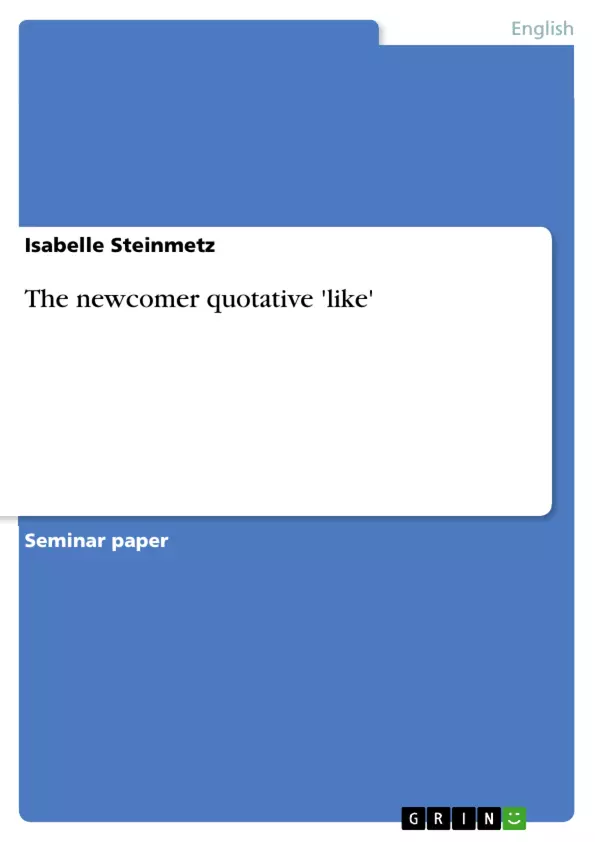The aim of this paper is the examination of the word 'like' as a newcomer quotative in the English-speaking world and to test results from previous studies on 'like' as a quotative. Speakers always have several options to report something and they are free to choose from different quotatives or verba dicendi in order to be able to introduce dialogues. Over the last years the number of quotatives which are at speakers’ disposal increased as new quotatives came into being. This paper seeks to test latest findings and hypotheses about verba dicendi in general and the quotative like in particular. It does so using a qualitative analysis of subjects reporting a short scene from the TV show "Friends".
Inhaltsverzeichnis (Table of Contents)
- 1. Introduction
- 2. Precautions for the Linguistic Study
- 2.1 How like was elicited in previous studies
- 2.2 The report of a short scene from a TV series to evoke the use of like as a quotative
- 2.3. The particular scene in detail
- 2.4 Reasons for choosing the scene
- 3. Description of the Linguistic Study
- 3.1 Procedure
- 3.2 The subject cohort
- 4. Results of the reports
- 4.1 Attitudinal Survey
- 5. Conclusion
- 6. References
Zielsetzung und Themenschwerpunkte (Objectives and Key Themes)
This paper aims to analyze the use of the word 'like' as a quotative in English, particularly examining whether previous findings on this phenomenon still hold true. It investigates the usage of 'like' within a specific context, analyzing how speakers report dialogues from a short scene from a TV series. This study aims to contribute to the understanding of the evolving landscape of quotatives in English and to identify factors influencing the preference for certain quotatives, such as gender and region.
- The emergence of new quotative forms in English and their impact on language varieties
- The role of context and speaker characteristics in the choice of quotatives
- The attitudinal reception and perception of 'like' as a quotative
- The comparison of 'like' to other existing quotatives, including traditional verbs of saying
- The interplay of direct and indirect quotation in speech reporting
Zusammenfassung der Kapitel (Chapter Summaries)
The paper begins by providing a comprehensive overview of the existing research on the use of 'like' as a quotative, highlighting previous studies and their findings. The second chapter focuses on the methodology employed in the study, detailing the use of a short scene from a TV series to elicit the use of 'like' as a quotative. The third chapter describes the specific procedure followed in the study, outlining the subject cohort and the methods used to collect data. The paper then presents the results of the analysis of the collected data in the fourth chapter, focusing on the usage patterns of 'like' and other quotatives. While the study examines several aspects of the language, it focuses primarily on the use of quotatives, specifically the frequency of their occurrence in spoken English and the factors that might influence their selection. The study also explores the attitudinal responses to the use of 'like' as a quotative.
Schlüsselwörter (Keywords)
The paper focuses on the use of 'like' as a quotative in English, examining its evolution as a new verb of saying. The study analyzes speaker preferences for various quotatives, exploring the role of factors like gender, age, and region. The analysis includes a comparison of 'like' to traditional verbs of saying and investigates the influence of context on the choice of quotatives.
- Quote paper
- Isabelle Steinmetz (Author), 2014, The newcomer quotative 'like', Munich, GRIN Verlag, https://www.grin.com/document/354243



